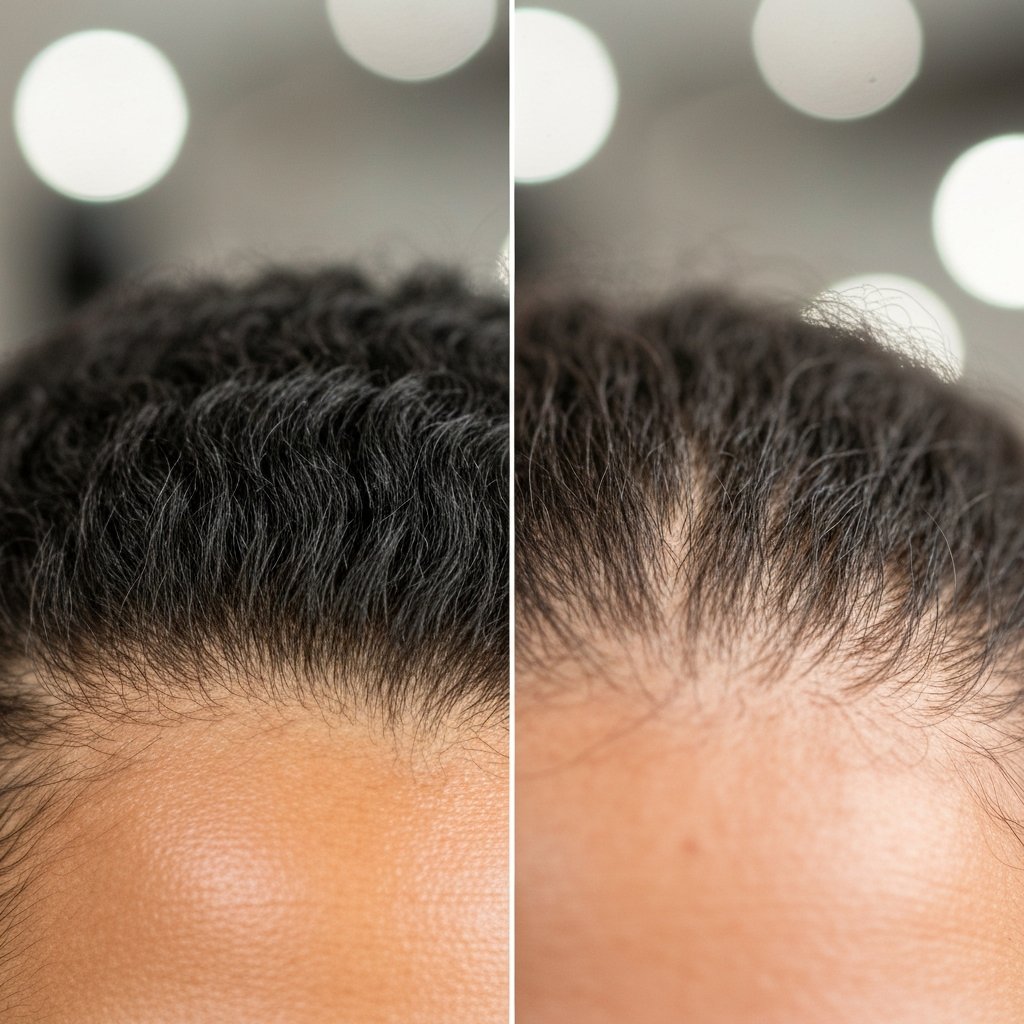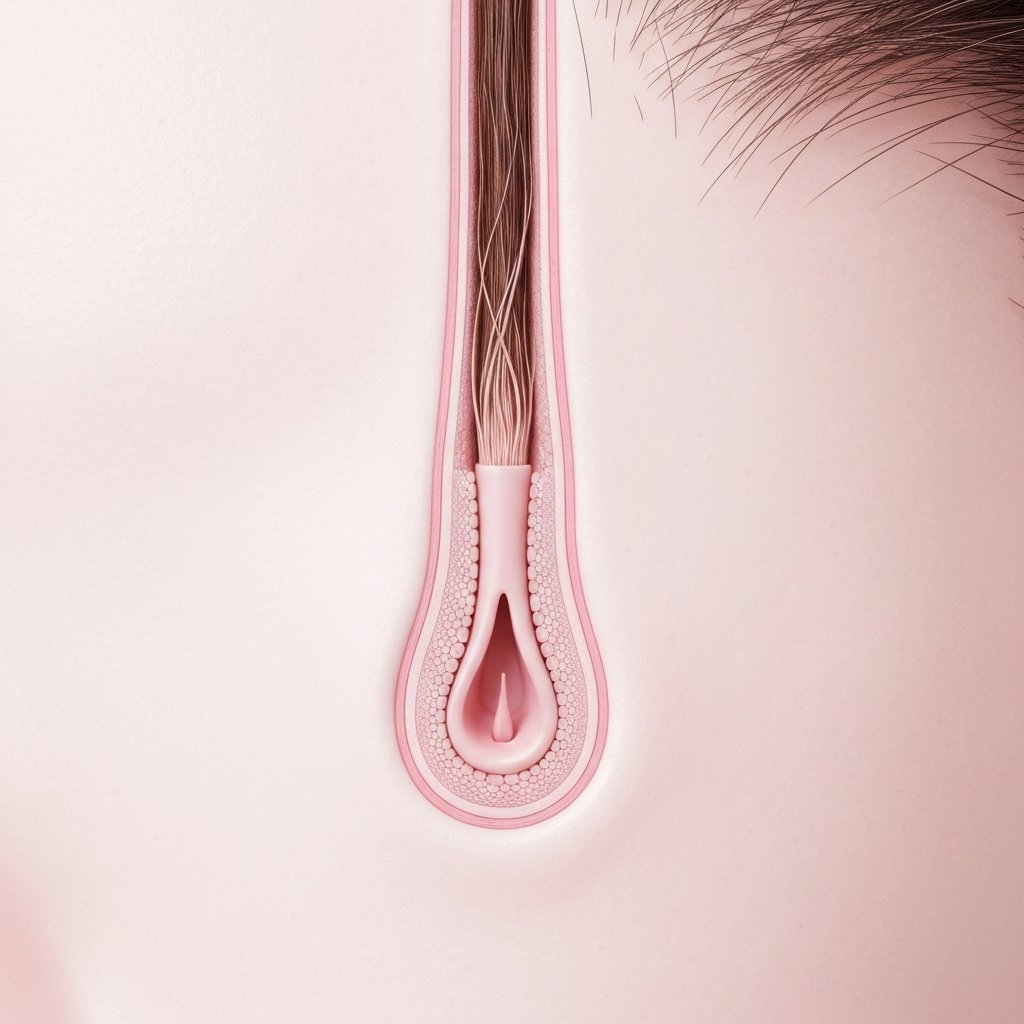
How to Make Fine Hair Look Thicker: Expert Styling Tricks & Product Guide
11 min read

11 min read

11 min read

9 min read

16 min read

16 min read

13 min read
The hairline, often affectionately referred to as "edges," is arguably the most fragile and delicate section of hair on the human head. These fine strands framing the face are susceptible to a multitude of stressors, ranging from environmental factors to mechanical manipulation. For many, the quest for the perfectly sleek ponytail or the most intricate braided style has come at a steep cost: thinning edges and receding hairlines. Understanding how to prevent hairline breakage is not merely about vanity; it is about preserving the structural integrity of the hair follicle and maintaining long-term scalp health.
Hairline breakage is rarely an overnight occurrence. It is typically the result of cumulative damage—a slow erosion of the hair shaft caused by consistent tension, chemical over-processing, or lack of moisture. By the time visible thinning occurs, the damage has often been compounding for months. However, the narrative does not have to end with permanent loss. With a targeted approach to care, a revision of styling habits, and a dedication to scalp health, it is entirely possible to restore vitality to this delicate area.
In this comprehensive guide, we will explore the root causes of edge thinning, scientifically backed methods for restoration, and the daily habits necessary to maintain a lush, full hairline. Whether you are currently battling breakage or simply wish to proactively protect your edges, this information serves as a blueprint for healthier hair.
To effectively combat breakage, one must first understand why the hairline is so vulnerable. The hair strands located at the temples and forehead—often called vellus hair or "baby hairs"—are naturally finer and have a shorter growth cycle than the terminal hair found at the crown or back of the head. This means they possess a smaller diameter and less structural reinforcement, making them significantly more prone to snapping under pressure.

Furthermore, the hairline is the primary point of contact for many styling routines. It is the area most frequently brushed, gelled, and pulled. When you pull your hair back into a ponytail, the tension is not distributed evenly; the highest load of force is often placed directly on the frontal hairline. This mechanical stress can lead to a condition known as Traction Alopecia, a form of gradual hair loss caused by pulling force applied to the hair. Unlike genetic hair loss, this is almost entirely preventable and, in early stages, reversible.
Beyond mechanical stress, the hairline often suffers from chemical fatigue. Facial cleansers, makeup, and sweat can accumulate along the hairline, altering the pH balance of the scalp and drying out the hair. When combined with the frequent application of high-hold edge control gels—many of which contain drying alcohols—the result is a recipe for brittleness and breakage. Recognizing these anatomical and environmental vulnerabilities is the first step toward implementing a successful recovery plan.
In the era of "snatched" ponytails and intricate cornrows, the pressure to have a perfectly laid hairline is immense. However, the most effective way to prevent hairline breakage is to radically reduce the tension applied to this area. Tight hairstyles are the enemy of healthy edges. If a hairstyle causes bumps, redness, or a headache, it is too tight, and the follicles are screaming for relief. Constant tension causes inflammation around the hair follicle, which can eventually lead to scarring and permanent hair loss.

Professional stylists recommend adopting a rotation of low-manipulation styles. If you wear high puffs or ponytails, use fabric-covered elastics or spiral hair ties rather than rubber bands, which can snag and shear the hair. More importantly, vary the placement of your ponytail. Wearing your hair in the exact same position every day places stress on the exact same follicles repeatedly. By moving the anchor point of your style—low one day, high the next, loose the following—you distribute the tension and give your edges a chance to recover.
When it comes to protective styles like box braids, twists, or weaves, the installation technique is critical. It is imperative to leave the fine baby hairs out of the tension of the braid. Incorporating these microscopic strands into a heavy braid creates a weight ratio that the follicle cannot support. A professional braider should always be willing to leave the edges loose or use a "knotless" technique that begins with the natural hair and gradually adds extensions, significantly reducing tension at the root.
The damage done to your hairline doesn't stop when the sun goes down. In fact, friction during sleep is a silent killer of edges. Cotton pillowcases are highly absorbent and abrasive. As you toss and turn during the night, the cotton fibers act like mild sandpaper against your delicate hairline, stripping away moisture and causing friction-induced breakage. Over time, this nightly wear and tear can result in significant thinning, particularly on the side of the head you favor sleeping on.

The solution is simple but non-negotiable: create a barrier between your hair and abrasive surfaces. Satin or silk bonnets and scarves are essential tools in the fight against breakage. Unlike cotton, silk and satin fibers are smooth and non-absorbent, allowing hair to glide over the surface without friction while retaining its natural oils. For those who find bonnets uncomfortable or prone to slipping off, investing in a high-quality 100% mulberry silk pillowcase is an excellent alternative.
Additionally, your nighttime routine should involve removing any tension from the day. If your hair was in a bun or ponytail, take it down. If you used edge control gel, it is vital to gently remove the hardened residue before bed or apply a light oil to soften it. Sleeping with hard, gelled hair can cause the strands to snap if they are manipulated while you sleep. A light massage with a penetrating oil like jojoba or almond oil before putting on your scarf can keep the edges pliable and hydrated throughout the night.
The market is flooded with products promising to "lay" edges for 24 hours or more, but the chemical composition of these products often contributes to the problem. Many edge control gels rely on high concentrations of alcohol to provide that quick-drying, cement-like hold. Short-chain alcohols (like SD alcohol 40, ethanol, and isopropyl) evaporate quickly, sucking moisture out of the hair shaft in the process. This leaves the already fragile baby hairs dry, brittle, and prone to snapping at the slightest touch.

To prevent hairline breakage, scrutiny of ingredient labels is required. Look for edge controls and gels that are water-based and formulated with humectants like glycerin or aloe vera. These ingredients attract moisture to the hair rather than repelling it. Furthermore, products containing hydrolyzed proteins can offer temporary structural support to weak strands, though protein should be used in moderation to avoid stiffness.
On the restorative side, natural oils play a pivotal role. Castor oil, specifically Jamaican Black Castor Oil (JBCO), has been lauded in the hair care community for its thickness and ability to seal in moisture. While no oil can magically sprout hair where a follicle is dead, the ricinoleic acid in castor oil helps improve circulation when massaged in, and its thick consistency protects the hair shaft from physical damage. Rosemary oil is another powerhouse; studies have suggested it can be as effective as minoxidil in encouraging circulation to the scalp. incorporating these into your routine targets the health of the follicle directly.
Sometimes, at-home care needs to be supplemented with professional intervention. If you are noticing persistent thinning despite changing your styling habits, visiting a salon that specializes in trichology or scalp health is a wise step. Professional stylists can offer high-intensity steam treatments that open the cuticle and allow hydration to penetrate deeper than standard conditioning masks. This elasticity is crucial for preventing breakage.

Another therapy gaining traction is Low-Level Laser Therapy (LLLT). Often available in dermatological clinics or high-end salons, red light therapy works by stimulating cellular activity within the hair follicle, potentially re-energizing dormant follicles and thickening existing strands. While this requires consistency and time, it is a non-invasive option for those worried about the permanence of their hairline recession.
Scalp facials are also becoming a staple service in modern salons. These treatments involve deep cleansing to remove buildup from heavy gels and sprays that can clog follicles and inhibit growth. A clogged follicle cannot produce a healthy hair strand. By using enzymatic exfoliants and professional-grade serums, a scalp facial resets the environment of the hairline, ensuring that the scalp is fertile ground for regrowth.
Hair health is a reflection of internal health. No amount of external oil can fully compensate for a nutritional deficiency. To prevent breakage and support strong growth at the hairline, one must fuel the body with the necessary building blocks. Hair is primarily made of keratin, a protein, so a diet adequate in protein is fundamental. However, micronutrients play an equally vital role.

Iron deficiency (anemia) is a common cause of hair thinning in women. If your edges are thinning and you also feel fatigued, a blood test may be in order. Biotin, Zinc, and Vitamin D are also critical for the hair growth cycle. Vitamin C is essential for collagen production and helps the body absorb iron. Incorporating foods like leafy greens, nuts, eggs, fatty fish, and citrus fruits can create a noticeable difference in hair resilience over time.
Hydration is equally important. Water is required for cell turnover and growth. A dehydrated body will prioritize vital organs over non-essential tissues like hair. Chronic dehydration results in dry, brittle hair that snaps easily. Aiming for adequate daily water intake is one of the cheapest and most effective ways to improve the elasticity of your hair strands, making them more resistant to breakage during styling.

Q: Can castor oil really regrow my edges? A: Castor oil is excellent for moisturizing and sealing the hair shaft, which prevents breakage and retains length. The massage action used to apply it stimulates blood flow, which can encourage growth, but the oil itself does not create new follicles if scarring has occurred.

Q: How long does it take to repair damaged edges? A: Patience is key. Hair grows approximately half an inch per month. If the follicles are still active, you may see fine fuzz appearing within 3 to 4 months of consistent care and low manipulation. Full density recovery can take 6 to 12 months.
Q: Are edge control gels bad for my hair? A: Not all of them, but many are. Gels with high alcohol content are drying and damaging. Gels that cause buildup can clog follicles. It is best to use water-based gels and wash them out regularly to prevent buildup.
Q: Is traction alopecia permanent? A: In its early stages, traction alopecia is reversible if the tension is stopped immediately. However, if the pulling continues for years and scarring occurs (cicatricial alopecia), the hair loss can become permanent. Early intervention is critical.
Q: Should I stop wearing braids if my edges are thinning? A: You don't necessarily have to stop forever, but you should take a significant break (3-6 months). When you return to braids, insist on knotless styles with larger sections and ensure the stylist leaves the fine baby hairs completely out of the braids.
Q: Can stress cause my hairline to break? A: Yes. Telogen Effluvium is a type of hair shedding triggered by stress. While it usually affects the whole head, the hairline is often where thinning is most visually apparent. Managing stress is part of hair care.
Preventing hairline breakage and restoring thinning edges is a journey that requires a shift in mindset from "styling at all costs" to "health first." It involves a holistic approach that combines gentle handling, protective nighttime routines, ingredient awareness, and internal wellness. The delicate nature of the hairline demands respect; it cannot withstand the same rough handling as the rest of your hair.

By implementing the strategies outlined in this guide—reducing tension, choosing the right products, and listening to your hair's needs—you can halt the progression of breakage. Remember that consistency is the secret ingredient. You may not see results in a week, but with three months of dedicated care, your edges can transform from fragile and thinning to lush and resilient. Consult with professional stylists for personalized assessments, and embrace the beauty of your natural, healthy hairline.